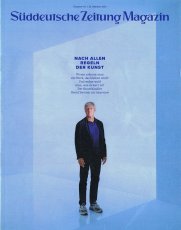|
Titel
-
Raymond Pettibon - Here´s your irony back - political works 1975-2013
Technische
Angaben
-
212 S., 32,7x27,5 cm, ISBN/ISSN 9783775737333
Hardcover mit Schutzumschlag, bedrucktes Vorsatzpapier
ZusatzInfos
-
Mit einem Essay von Benjam H. D. Buchloh.
Raymond Pettibon (Raymond Ginn) (*1957 in Tucson), Pionier von Subkultur und kulturellem Untergrund in Südkalifornien, löst seit den späten 1970er-Jahren die Grenzen zwischen Hochkultur und Massenphänomenen, zwischen Kunstgeschichte und Literatur einerseits sowie Jugendritualen, Sport, Religion, Politik und Sexualität andererseits stetig auf. All dies schlägt sich in seinen bis ins Detail ausgearbeiteten Zeichnungen nieder. Mit seinen freien poetischen und zugleich scharfsinnigen Kompositionen hält Pettibon der gegenwärtigen Gesellschaft einen Spiegel vor. Außer von politischen Akteuren wird sein Schaffen seit dem 11.09.2001 verstärkt durch zeithistorische Ereignisse inspiriert. Ronald und Nancy Reagan, J. Edgar Hoover, die Präsidenten Bush, die Kennedys und Adolf Hitler, Barack Obama und Osama bin Laden finden sich neben Szenen aus dem Vietnamkrieg und den Kriegen im Irak und in Afghanistan, neben Misshandlungen in Abu Ghraib und Protestbewegungen.
Text von der Website
|
Titel
-
Selected works from 1990's
Technische
Angaben
-
[32] S., 19x13 cm, Auflage: 500, keine weiteren Angaben vorhanden
Drahtheftung, Schwarz-Weiss Offsetdruck
ZusatzInfos
-
The William Crawford Estate is owned and represented by Ampersand Gallery. William Crawford's drawings were discovered in an abandoned house in Oakland, California. His work brings to mind characteristics of prison drawings, an impression confirmed by the fact that several were made on the backs of prison roster sheets dated 1997. These printouts, however, were cut down the middle, so the exact prison from which they originate is unknown. But given their origin in the Bay Area and the fact that several drawings include San Francisco landmarks, it's possible that Crawford made the work in a California state prison. Other than this information drawn from the archive itself, nothing is known about Crawford's life. Indeed, we only know his name because he signed just a few of the drawings, either as Bill, William or WM Crawford. The archive appears to have consisted of several books, with individual drawings in sequences of 30 or more adding up to tell complex visual stories. Several include written captions or fragments of conversation between male and female characters. These sequences, however, have been broken up over the years and reach us now in a fragmentary and fascinating collection of hundreds of delicate pencil drawings. The work conveys the intense sense of sexual longing of a man with an urge to tell dynamic stories. The drawings, which resemble the eroticism of Eric Stanton, the exaggerated male anatomy of Tom of Finland or the ample breasts of a John Currin, show scantily dressed women, drug use, cuckolding and orgies. The details of his interiors, the hairdos and style of dress suggest that Crawford might have come of age in the late 70s or early 80s. A cast of recurring figures populate the drawings, notably one man with a short afro and a moustache who often figures at the center of events, presumably the artist William Crawford himself. Remarkably, given the number of drawings, there is little to no repetition in the work. Crawford’s inventive eye for sexual positions, facial expressions and gestures of hand and body was vast and masterful. Simple geometric details and architectural subtleties define the unusual settings where the action unfolds. We see rooms shown from unusual angles, features that are hinted at, erased or altogether omitted and articles of clothing that are drawn with obsessive precision. This singular and original drawing style compels us to immerse ourselves in the world William Crawford created, more dream than documentation, more fantasy than perversion. Crawford's drawings have been widely exhibited, notably at Galerie Susanne Zander (Cologne and Berlin), Zieher, Smith and Horton (New York), Freddy (Baltimore) and upcoming solo exhibitions at FARAGO (Los Angeles) and Richardson (New York). His work is also featured in the latest issue of Richardson Magazine and was included in "System and Vision" at David Zwirner, an exhibition organized in collaboration with Delmes & Zander. Reviewing it, The New Yorker wrote, "William Crawford's orgiastic illustrations on the backs of prison rosters haven an erotic intensity that rivals anything by Hans Bellmer or Pierre Klossowski."
Text von der Webseite
|
Titel
-
David Zwirner Books Fall 2017
Technische
Angaben
-
32 S., 25,5x20,3 cm, ISBN/ISSN 7981941701720
Broschur
ZusatzInfos
-
Lieferverzeichnis Herbst 2017
|
Titel
-
Es ist essenziell, die Kunst von der Persönlichkeit des Künstlers zu trennen
Technische
Angaben
-
44 S., 30x22 cm, keine weiteren Angaben vorhanden
Artikel in Süddeutsche Zeitung Magazin Nummer 43 vom 25.11.2024, Seite 12 ff
ZusatzInfos
-
Interview mit David Zwirner, einem der renommiertesten Kunsthändler der Welt.
|
Copyrighthinweis: Das Copyright für die abgebildeten Publikationen bleibt bei den jeweiligen Rechteinhabern (Autoren, Künstlern, Fotografen, Gestaltern, Publizisten). Die Abbildungen und Textzitate dienen der künstlerischen und wissenschaftlichen Recherche.
Hier werden Werke dokumentiert, die sonst nur schwer oder gar nicht zugänglich wären. Wer nicht damit einverstanden ist, dass sein Werk auf dieser Webseite gezeigt wird, kann die Abbildung umgehend durch mich löschen lassen.
Für wissenschaftliche Recherchen können die großen Abbildungen auf Antrag freigeschaltet werden.
Wenn Sie als Rechteinhaber möchten, dass Ihre Abbildungen bei Klick größer gezeigt werden (Höhe x Breite = ca. 800 x 1200 Px), dann melden Sie sich bitte bei mir:









